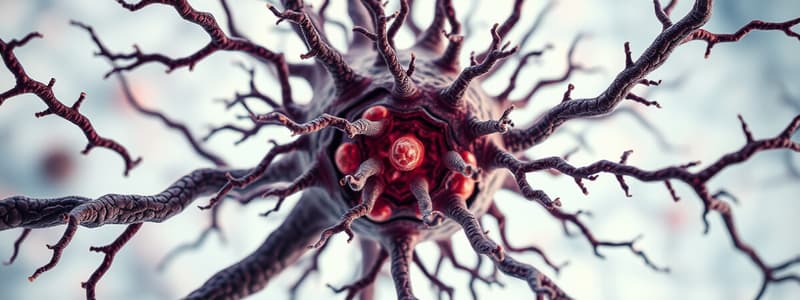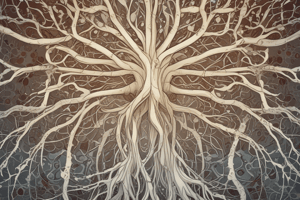Podcast
Questions and Answers
What are interneurons also called?
What are interneurons also called?
association neurons
What percentage of the body's neurons are interneurons?
What percentage of the body's neurons are interneurons?
- 99% (correct)
- 90%
- 50%
- 75%
What is a transgenic organism?
What is a transgenic organism?
An organism with genes inserted into its genome that weren't originally there.
Which of the following is NOT a classification of neurons based on neurotransmitter type?
Which of the following is NOT a classification of neurons based on neurotransmitter type?
The four main types of neuroglia that support CNS neurons are astrocytes, microglial cells, ependymal cells, and ______.
The four main types of neuroglia that support CNS neurons are astrocytes, microglial cells, ependymal cells, and ______.
Astrocytes are the least abundant type of glial cells.
Astrocytes are the least abundant type of glial cells.
What is the function of oligodendrocytes?
What is the function of oligodendrocytes?
What do myelin sheaths primarily protect and insulate?
What do myelin sheaths primarily protect and insulate?
Myelinated fibers conduct impulses more slowly than nonmyelinated fibers.
Myelinated fibers conduct impulses more slowly than nonmyelinated fibers.
What are the two major types of glia seen in the peripheral nervous system (PNS)?
What are the two major types of glia seen in the peripheral nervous system (PNS)?
Myelin sheath gaps are formerly called ______.
Myelin sheath gaps are formerly called ______.
What are the two main types of histology techniques that advanced our understanding of neuroscience?
What are the two main types of histology techniques that advanced our understanding of neuroscience?
What staining technique is named after Franz Nissl?
What staining technique is named after Franz Nissl?
What is the term for the biosynthetic center of a neuron?
What is the term for the biosynthetic center of a neuron?
What structures make up the neuronal cytoskeleton?
What structures make up the neuronal cytoskeleton?
Neurons can easily regenerate after injury.
Neurons can easily regenerate after injury.
What do the Nissl bodies in a neuron consist of?
What do the Nissl bodies in a neuron consist of?
Which characteristic makes axons unique compared to dendrites?
Which characteristic makes axons unique compared to dendrites?
Which type of neuron is most common in the central nervous system?
Which type of neuron is most common in the central nervous system?
The Nissl stain is useful for determining the distribution and density of neuronal cell bodies.
The Nissl stain is useful for determining the distribution and density of neuronal cell bodies.
The __________ is responsible for gene expression and RNA processing within the neuron.
The __________ is responsible for gene expression and RNA processing within the neuron.
Flashcards are hidden until you start studying
Study Notes
Historical Context & Histological Methods
- Histology is the microscopic study of tissue structure, crucial for understanding neuroscience.
- Nissl stain / Cresyl Violet: Stains neuronal cell bodies blue, facilitating cytoarchitecture studies in the CNS.
- Golgi stain: Allows detailed visualization of neuron structure, differentiating soma from neurites (axons and dendrites).
- Santiago Ramón y Cajal utilized Golgi staining to help establish the neuron doctrine, positing that individual neurons are distinct and not physically connected.
Neuron Doctrine
- Fundamental principle that individual neurons are the smallest functional units of the nervous system; adheres to cell theory.
- Neural circuitry emphasizes how neurons communicate via contact rather than continuity.
Neurons Overview
- Neurons are large, specialized cells responsible for impulse conduction, with extreme longevity and high metabolic demands.
- Neurons are typically amitotic, producing few new cells over a lifetime.
- Composed of a cell body (soma), which contains organelles and a plasma membrane that receives input from other neurons.
Neuronal Structures
- Cell Body (Soma): Contains a nucleus, ribosomes (for protein synthesis), rough/smooth endoplasmic reticulum, and Golgi apparatus.
- Ribosomes: Sit mainly on rough ER, crucial for synthesizing proteins necessary for neuronal function.
- Mitochondria: Powerhouse of the cell, generating ATP through cellular respiration.
- Cytoskeleton: Composed of microtubules, microfilaments, and neurofilaments; provides structural support and dynamic shape changes. Microtubules are integral in transporting organelles within neurons.
Neuron Processes
- Dendrites: Short, branched processes that receive signals and convey graded potentials toward the cell body.
- Axon: Singular long projection of a neuron, initiating at the axon hillock; transmits impulses away from the cell body. Can measure over a meter in length.
- Axons possess axon collaterals, branching at the terminus into numerous axon terminals, which release neurotransmitters.
Axonal Transport
- Anterograde transport: Carries materials from cell body to axon terminals; involves mitochondria and enzymes.
- Retrograde transport: Moves materials from axon terminals back to the cell body; can include organelles and viral particles, influencing research for genetic diseases.
Synaptic Transmission
- Neuronal communication primarily occurs at synapses, where electrical signals convert to chemical signals, facilitating interactions between neurons.
- Types of Neurons: Categorized structurally (multipolar, bipolar, unipolar) and functionally (sensory, motor, interneurons).
- Multipolar: Common in CNS, contains multiple dendrites and one axon.
- Bipolar: Found in senses like vision and smell; has one axon and one dendrite.
- Unipolar: Features a T-like structure; primarily associated with sensory receptors.
Genetic Classifications
- Neurons can also be classified based on gene expression; techniques like creating transgenic mice allow the tagging and studying of specific neuron types.
- Neurotransmitter-based classification: Includes categories such as cholinergic (acetylcholine), serotonergic (serotonin), and dopaminergic (dopamine).
Glial Cells
- Support neurons in various capacities in both the central (CNS) and peripheral (PNS) nervous systems.### Historical Context & Neuron Doctrine
- The neuron doctrine is a fundamental principle in neuroscience, establishing that neurons are the basic structural and functional units of the nervous system.
- Histological techniques, such as Golgi staining, were pivotal in visualizing individual neurons and their connections, leading to the acceptance of the neuron doctrine.
Basics of Neuron Biology
- Neurons are specialized cells responsible for transmitting nerve impulses across the nervous system.
- Classification includes sensory neurons, motor neurons, and interneurons, each serving distinct functions.
Role of Glial Cells in Nervous System
- Glial cells, or neuroglia, support both the central nervous system (CNS) and peripheral nervous system (PNS).
- Four main types of glial cells in the CNS: astrocytes, microglial cells, ependymal cells, and oligodendrocytes.
Astrocytes
- Most abundant glial cells, highly branched, and versatile in their functions.
- Support neurons physically and chemically, control the extracellular environment, and guide young neuron migration.
- Participate in synaptic transmission and overall brain information processing.
Microglial Cells
- Small, ovoid glial cells with processes that monitor neuron health.
- Key role in immune response, migrating towards injured neurons and phagocytizing debris and pathogens.
Ependymal Cells
- Epithelial-like cells lining cavities in the CNS, varying in shape from squamous to columnar.
- Ciliated ependymal cells help circulate cerebrospinal fluid (CSF) and act as a barrier between CSF and neural tissue.
Oligodendrocytes
- Branched cells that wrap around CNS axons to form myelin sheaths.
- Myelin is essential for insulating axons, increasing nerve impulse speed, and preventing ion leakage.
Myelin Sheaths
- Comprised of a protein-lipid substance called myelin, facilitating rapid electrical conduction along axons.
- Myelinated fibers have a segmented structure, while nonmyelinated fibers conduct impulses more slowly.
CNS Myelination
- Oligodendrocytes can wrap multiple axons simultaneously, forming myelin sheaths without full cell encapsulation.
- Myelin sheath gaps (nodes of Ranvier) are crucial for快速传输信号.
White and Gray Matter
- White matter contains myelinated fiber tracts, while gray matter consists mainly of neuron cell bodies and nonmyelinated fibers.
PNS Glial Cells
- Two main types in the PNS: satellite cells and Schwann cells.
- Satellite cells surround neuron cell bodies, functioning like astrocytes.
- Schwann cells form myelin sheaths around PNS axons and are integral in the regeneration of damaged peripheral nerves.
PNS Myelination
- Schwann cells envelop axons in a spiraled manner, with each cell forming a myelin segment.
- Outer collar of perinuclear cytoplasm (neurilemma) surrounds myelinated axons, aiding in nerve insulation.
Myelin Sheath Gaps in PNS
- Gaps between Schwann cells, also known as nodes of Ranvier, allow for the emergence of axon collaterals and rapid impulse conduction.
Quiz Hint
- Remember types of glia and their general roles, focusing on their diverse functions across the CNS and PNS.
Studying That Suits You
Use AI to generate personalized quizzes and flashcards to suit your learning preferences.




